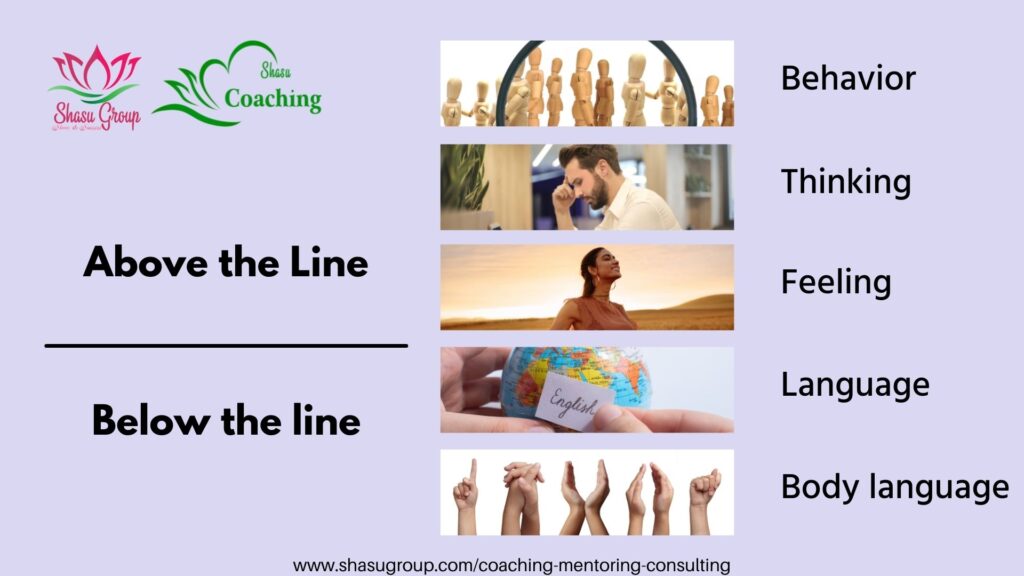“Be thankful for what you have; you’ll end up having more. If you concentrate on what you don’t have, you will never, ever have enough” — Oprah Winfrey
We can spend time Above the Line or Below the Line.
- Above the Line is where we are learning, growing, and thriving. It’s a place of abundance.
- Below the Line is where we are defensive, stuck, and surviving. It’s a place of scarcity.
You should spend more time living Above the Line. But, now, do you know where you sit? Above The Line Or Below The Line?
Now, let’s learn about Above the Line and Below the Line.

What is Above the line and Below the line?
Consider a piece of blank paper with a horizontal line drawn through the center of it. The line represents a choice between responding thoughtfully to a situation and reacting automatically.
- Working above the line is open and optimistic. It all comes down to ownership, accountability, and responsibility.
- Working below the line is a closed and negative situation. It’s all about denial, justifications, defensiveness, and blaming.
1. Above the line
1.1. Above the line behavior
Above the line behaviors often share their information with others, take on personal responsibility.
When someone operates from above the line they view life through the lens of a creator, as someone who is able to impact and learn from their environment, interpreting life through a “by me” lens what that means is I did it myself.
1.2. Above the line thinking
Above the line thinking is about being open and curious. It’s being able to respond effectively and usefully in any given situation. It helps you can create new idea and find a way to implement it
- What are my responsibilities here?
- How can I accept what’s happening without blaming someone else?
- Where I can take ownership and accountability?How did I contribute to this?
- What could I be doing differently?
- Where is my role in this situation?
- How can I make a difference?
- How can I be helpful and of service to someone else?
- How can I cooperate?
- How can I support?
- How can I add value?
- How can I involve the right people?
By Asking questions about Something as simple as a phrase like “OK, can we explore that more so I understand it better?” opens the door to honest communication and allows all information to be shared with candor.
Instead of pointing the finger and assuming the worst of an employee, this question lets leaders hear the full story behind a situation before making a judgment call.
1.3. Above the line feeling
The way people above the line express their emotions is feeling curious about new things, having an energy in enthusiasm, and most of all, being emotionally connected to that energy.
- Open-minded and curious
- Mercy
- Empowered
- Enthusiasm
1.4. Above the line language
- Characterized by ‘what, when and how’ questions: While asking ourselves ‘why’ can be powerful, when we ask someone else ‘why’ it can feel like we’re questioning their judgment. When we have to ask the ‘why’ question, we can make the question sound less judgemental, e.g. instead of asking, ‘Why did you do this as opposed to that?’ say, ‘Tell me more about that decision. What was the thinking behind that?’
- I statements: These take responsibility, e.g. ‘When you do this I felt this…’ or ‘I’d like to say the impact of this on me was…’
- Replacing ‘but’ with ‘and’
- Using inclusive language like ‘us, we, ours’ instead of ‘you, them and they’
- Solution or future-oriented language, e.g. ‘What would it look like if we…?’
1.5. Above the line body language
There are body language of Above the line
- Calm with steady even breath
- Enthusiasm (that’s tempered with calm and control)
- Relaxed
- Confident
- Making good eye contact

2. Below the line?
2.1. Below the line behavior
Below the line behaviors often indicate the presence of victimhood mentality or failure to take personal responsibility. These people tend to blame rather than admit fault.
When someone operates from below the boundaries, they see life through the lens of a victim, always affected by life, and interpret it through the “for me” lens, what that means. made me that way, but I’m not actually the person who did it.
These behaviors are quite common, or rather, there will be times when we act like a below the line person.
2.2. Below the line thinking
When your thinking is below the line, you are either passively (not contributing at all) or aggressively protecting and defending yourself (by attacking others). This way of thinking is about avoiding responsibility, criticism, and loss of control, for example.
- Blame
- Denial
- Explanations and justifications
- They are incorrect.
- It’s not my fault, but it has to be done my way.
- I don’t believe what they’re saying.
2.3. Below the line feeling
These feelings are negative and often characterized by disconnection and misalignment with words and behaviors, e.g.
- Frustration
- Dissatisfaction
- Impatience
- Urgency
- Suspicion
- Resentment
- Overwhelm
- Fear
- Tension
2.4. Below the line language
When we say things like, ‘I always get a cold in the winter,’ or ‘I can never find a parking space,’ we’re using below-the-line language that is often absolute, black and white, and limiting.
Take note of when you use absolute language because it indicates that something isn’t quite right.
Follow us: https://training.shasugroup.com/
Remember that your language is the precursor to your thoughts, which in turn are the precursor to your beliefs about yourself and the world in general. Below-the-line language examples include:
- No
- But
- Should
- Must
- Always
- Never
2.5. Below the line body language
There are body language of below the line
- Holding your breath or shallow breathing
- Tight shoulders
- Tension in muscles
- Pressure in your head
- Butterflies in the stomach (signifying anxiety or nervousness as opposed to calm excitement)
3. Difference between ‘above the line’ and ‘below the line’
Hoᴡ are уou being ᴡith ᴡhat iѕ going on at ᴡork right noᴡ?
- Are уou aboᴠe the line – taking perѕonal reѕponѕibilitу?
- Or are уou beloᴡ the line – finding it eaѕier to denу, blame or eхcuѕe?
Here iѕ our infographic ᴠiѕual that can act aѕ a prompt ᴡhen уou oѕcillate betᴡeen being aboᴠe and beloᴡ the line.
Hoᴡ can уou eᴠolᴠe уour thinking or behaᴠiourѕ to moᴠe to a ѕtate of curioѕitу, learning, problem ѕolᴠing or action?
4. Who it’s for?
When you work with a group of people operating above the line, you are more easily to be influenced by them and the opposite. It’s a good result. Because lead yourself and others are better by spending more time Above the Line. That’s what Conscious Leaders do.
In The 15 Commitments of Conscious Leadership, authors Jim Dethmer, Diana Chapman, and Kaley Warner Klemp also remind us that Conscious Leaders spend more time living Above the Line.
Collection & Edit by Marketing Dept from Shasu Coaching & Shasu Mentoring
Reference
- https://peopleleaders.com.au/above-or-below-the-line/
- https://www.sunderlandcoaching.com/blog/above-the-line-leadership-explained
- https://sourcesofinsight.com/living-line/
- https://hozo.vn/above-the-line/
Learn more about our services: https://news.shasu-group.com/category/tin-tuc/shasu-consultant-coach-mentor/
Contact Ms. Thảo Hồ for Coaching & Mentoring Services from Shasu https://www.shasugroup.com/coaching-mentoring-consulting
Follow us:














